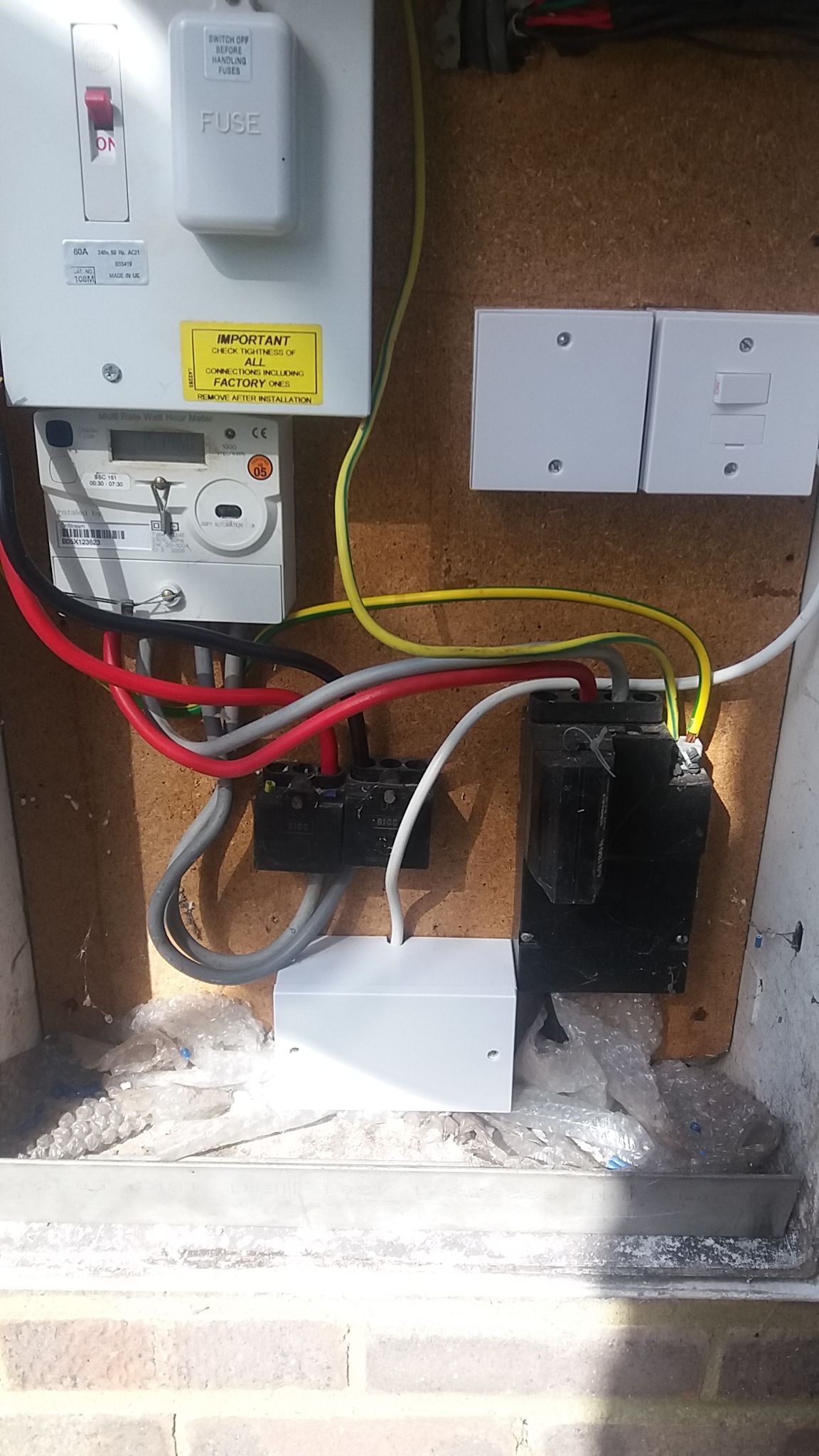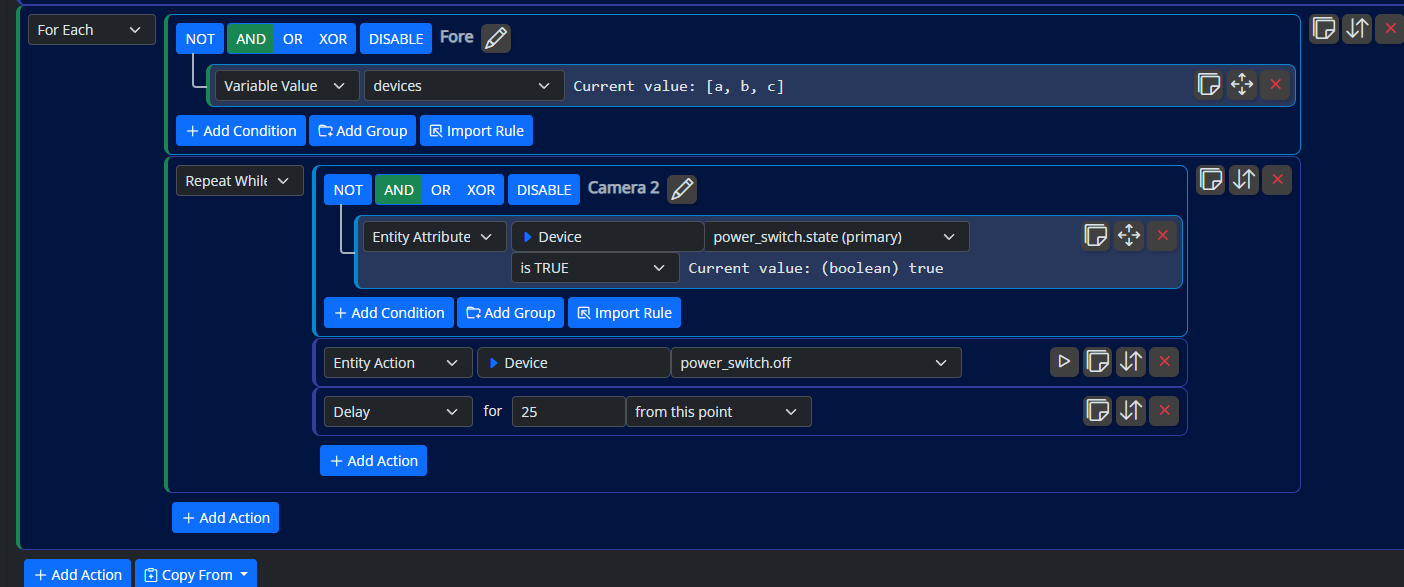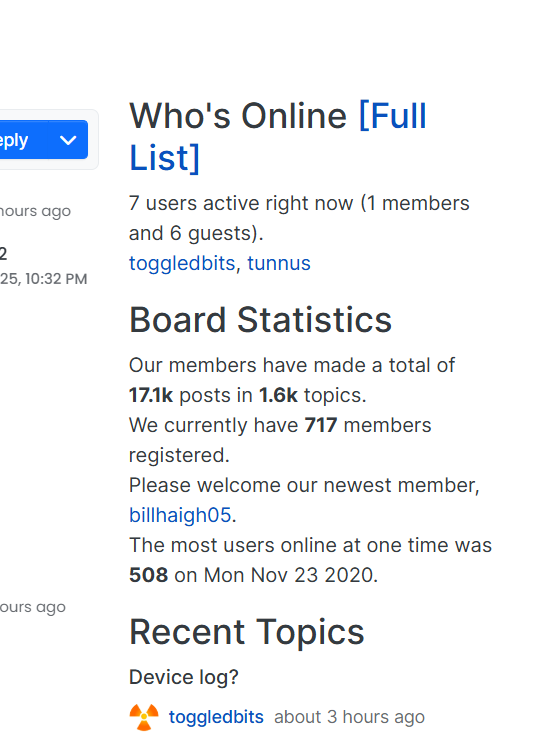@cw-kid I have not been able to login since the 28/03.
As to rebel, just a little more blunt than you. As I see it someone was on a purge.
Shame they are purging people that help others, specially vera support, still plenty of support here though.
Elcid
Posts
-
Not so quiet around here :) -
My WanderingI am a Electrician. I installed hundreds of smart devices for others prior to having my own home automation. In 2013 I bought a new house and decided to make it smart. I did some homework and settled on Z-wave and VeraPlus.
My installation comprises of
25 Z-wave dimmer/switch inserts
3 Z-wave door sensors
10 sonoff devices(basics,TH16 and Mini) ,
4 Tuya(lamps and RGB strips) ,
6 shellys(connected to motion sensors and 2 controlling dead DIY bolts )
3 Amazon Dots(gen2)
2 Broadlink (RMPro's)
4 DIY RF Venetian Blinds
2 Multi button DIY remotes
1 NVR
1 Network drive/Media server/ftp server.
1 smart thermostat heating and hot water
4 wired 240v/battery Aico smoke and heat detectors (connect to zwave via Relays)
1 robot hover.
1 Siren
Node-red server running on android.
Testing openluup on android.
Automate App running on andorid Boxes/phones.
All tv's are connected to android boxes.
No windows PC.
Debian running on android box.
Plugins Reactor, AlexaTTS, Switchboard and Virtual HTTP Switch.I can control all of my devices from anyone of these platforms Vera/OpenLuup, Node-red, Automate(phone/tv box) or Alexa.
All devices have a standard/manual switch for anyone to control, and can be controlled even if my VeraPlus stopped working or internet out. My system is stable and may get a luup reload every couple of weeks.None of my sonoff's or tuya have been flashed. I found Shelly very late into game and will be using these more now i found them, as they offer local control.
I have some coding knowledge from the 90's, but have never worked in the industry.
-
Alarm ClockI now have node-red setting a silent switching of a v device, by saying "wake me up at [any time and/or day]". also depending which echo i use i can set a different v device, so different morning routines for each bedroom.
@catman you can also do all your H A Bridge devices in node red to, as it has the local hue lights bridge to. So you could replace H A Bridge with node-red. It would not be difficult to set a http request to set your virtual alarm.
-
First post to say helloHi to all, Thought i would join as not to miss out on anygood information that you developers may share here.
note- The input box for text does not display to well.I can not see what i am typing.
Android 8 full sreen on tv box using firefox mobile view.
If i use desktop view everything is ok. -
This is me@CatmanV2 said in This is me:
Well, if I see further, it's because I stand of the shoulders of giants. I've got where I got because of the experts here.
Well said.
-
Not so quiet around here :)Yes i am here, as always I will help anyone who asks.
Just for info - I have no idea what the reason for my suspension, I have contacted CS but they seem to be just ignoring my request for a clear reason.
As to GDPR if they run servers in europe then we are covered by GDPR, even if they move the servers to the US, as I think there is a privacy agreement with the US.
-
Setting RGB colour values0.5019607843137255, 0, 0.5019607843137255 You may want to round them. LOL
-
Removing Orange NotificationYes thanks for your efforts @DesT
-
Lua example http post request with json body-- https request json body -- Enable potentially unsafe lua code in, user account - security local https = require "ssl.https" local http = require "socket.http" local ltn12 = require "ltn12" local json = require "dkjson" local payload = {{"test", "test", null, 0}} --payload to be sent local request_body = { secret = "1.KAddd87s8s8FasL7-ze4KG_p5hrVg4Kee1-t3vnwGFhI=", to = "test@gmail.com", device = null, priority = "high", payload = payload } --the json body local response_body = {} request_body = json.encode(request_body) local r, c, h, s = https.request { url = 'https://llamalab.com/automate/cloud/message', method = 'POST', headers = { ["Content-Type"] = "application/json", ["Content-Length"] = string.len(request_body) }, source = ltn12.source.string(request_body), sink = ltn12.sink.table(response_body) } -
Expressions and LuaXP FunctionsisNaN([1,2,3]) and isNaN("ten"/2) and isNaN("ten" + "eight") are all true
-
Video DoorbellsMy door is covered by a hidden microwave sensor. when triggered reactor sends a http request to my phone or tv box, depending on home or away. My phone/box uses Automate to receive the http request, Automate then opens the camera app and displays the camera. I can talk and listen though the camera app. Normally takes 5-10 seconds to complete. If i am home vera sends a TTS to alexa, informing me there is some one at the door.
-
node-red Alexa OpenLuup/Vera voice integrationHere is a simple integration of OpenLuup/vera device to Alexa via Node-red.
The speed is fast sub 1 second responses.
Requirements -
node-red.
alexa.
node-red-contrib-amazon-echo(local Hue devices).
openluup or Vera (or any controller via http requests).Capabilities-
Binary switch.
dimming switch.
rgb switch.
Run scenes.Each alexa device node is configured in the topic of the amazon-echo device node -
(device number#type of switch)
bnary - 123#binary.
dimming - 123#dimming.
rgb - 123#colour (W/D is default 310 to adjust colour temp add value to end e.g. 123#colour#300
scene - 123#scene#124 (123 on 124 off. 124 can be omitted).Enter the ip of your controller in the http request block.
Just copy code and import into Node-red[ { "id": "de7838ac.ebead", "type": "amazon-echo-hub", "z": "8659fc6b.981b4", "port": "8980", "processinput": "0", "discovery": true, "x": 150, "y": 840, "wires": [ [ "cd0ae070.e98378", "a605448.899d8b8", "21ca89ff.b0f6ce" ] ] }, { "id": "a605448.899d8b8", "type": "amazon-echo-device", "z": "8659fc6b.981b4", "name": "bedroom four", "topic": "199#colour", "x": 410, "y": 860, "wires": [ [ "688830f.c57775" ] ] }, { "id": "21ca89ff.b0f6ce", "type": "amazon-echo-device", "z": "8659fc6b.981b4", "name": "app safe", "topic": "164#binary", "x": 390, "y": 900, "wires": [ [ "688830f.c57775" ] ] }, { "id": "cd0ae070.e98378", "type": "amazon-echo-device", "z": "8659fc6b.981b4", "name": "lounge 1", "topic": "8#dimming", "x": 390, "y": 940, "wires": [ [ "688830f.c57775" ] ] }, { "id": "688830f.c57775", "type": "function", "z": "8659fc6b.981b4", "name": "", "func": "let types = {\n \"dimming\":[\"urn:upnp-org:serviceId:Dimming1\",\"SetLoadLevelTarget\",\"newLoadlevelTarget\"],\n \"binary\":[\"urn:upnp-org:serviceId:SwitchPower1\",\"SetTarget\",\"newTargetValue\"],\n \"scene\":[\"urn:micasaverde-com:serviceId:HomeAutomationGateway1\",\"RunScene\",\"SceneNum\"],\n \"colour\":[\"urn:micasaverde-com:serviceId:Color1\",{\"tt\":\"SetColor\",\"hs\":\"SetColorRGB\",\"ct\":\"SetColorTemp\"},{\"tt\":\"newColorTarget\",\"hs\":\"newColorRGBTarget\",\"ct\":\"newColorTempTarget\"}] \t\n}\nfunction binaryPayload(device, type, turnOn, payload) {\n payload.id = \"action\";\n payload.serviceId = type[0];\n payload.DeviceNum = device;\n payload.action = type[1];\n payload[type[2]] = (turnOn === true ? 1 : 0);\n payload.message = payload[type[2]];\nreturn payload;\n}\n\nfunction dimmingPayload(device, type, level, payload) {\n payload.id = \"action\";\n payload.serviceId = type[0];\n payload.DeviceNum = device;\n payload.action = type[1];\n payload[type[2]] = level;\n payload.message = level;\nreturn payload;\n}\nfunction scenePayload(device, type, turnOn, payload) {\n payload.id = \"action\";\n payload.serviceId = type[0];\n payload.action = type[1];\n payload[type[2]] = (turnOn === true ? device[0] : (device[2] || device[0]));\n payload.message =\"Run Scene \" + payload[type[2]];\nreturn payload;\n}\n\nfunction rgbPayload(device, types, msg, payload) { \n if(msg.on === true && msg.meta.changes.on === false && msg.meta[\"input\"].on === true){\n payload = binaryPayload(device[0], types[\"binary\"], msg.on, {});\n }else if (msg.meta.changes.percentage && msg.on === true){\n payload = dimmingPayload(device[0], types[\"dimming\"], msg.percentage, {});\n }else if (msg.on === true && msg.colormode === \"hs\"){\n payload.id = \"action\";\n payload.serviceId = types[\"colour\"][0];\n payload.DeviceNum = device[0];\n payload.action = types[\"colour\"][1][\"hs\"];\n payload[types[\"colour\"][2][\"hs\"]] = msg.rgb.join(\",\");\n payload.message = msg.rgb.join(\",\");\n }else if (msg.on === true && msg.colormode === \"ct\"){\n let diff = msg.ct - (Number(device[2]) || 310);\n msg.ct = (diff < 0) ? \"D\" + Math.min(Math.abs(diff * 1.7),255).toFixed() : \"W\" + Math.abs(Math.min((diff * 1.7),255) - 255).toFixed();\n payload.id = \"action\";\n payload.serviceId = types[\"colour\"][0];\n payload.DeviceNum = device[0];\n payload.action = types[\"colour\"][1][\"ct\"];\n payload[types[\"colour\"][2][\"ct\"]] = msg.ct;\n payload.message = msg.ct;\n }\nreturn payload;\n}\n\nmsg.topic = msg.topic.split(\"#\").map(Function.prototype.call, String.prototype.trim);\nmsg.hold = msg.payload;\nmsg.payload = {};\nlet type = msg.topic[1] || \"binary\";\nif(msg.topic[1] === \"scene\"){\n msg.payload = scenePayload(msg.topic, types[\"scene\"], msg.on, {});\n}else if (msg.topic[1] === \"binary\" || msg.percentage === 0 || msg.on === false){\n msg.payload = binaryPayload(msg.topic[0], types[\"binary\"], msg.on, {});\n}else if(msg.topic[1] ===\"dimming\"){\n msg.payload = dimmingPayload(msg.topic[0], types[\"dimming\"], msg.percentage, {});\n}else if (msg.topic[1] === \"colour\"){\n msg.payload = rgbPayload(msg.topic, types, msg, {});\n}\nlet error = [\"green\", msg.topic[1] + \" | \" + msg.topic[0], msg.payload.message];\ndelete msg.payload.message;\nif (Object.keys(msg.payload).length < 1){\n error[0] =\"red\";\n error[2] =\"failed to create payload\";\n}\nnode.status({\"fill\": error[0],\"shape\":\"ring\",\"text\": error[1] + \" | \" + error[2]});\n\nreturn msg;\n", "outputs": 1, "noerr": 0, "initialize": "", "finalize": "", "x": 590, "y": 940, "wires": [ [ "680d28ae.8a163" ] ] }, { "id": "680d28ae.8a163", "type": "http request", "z": "8659fc6b.981b4", "name": "Get request", "method": "GET", "ret": "txt", "paytoqs": "query", "url": "http://192.168.1.11:3480/data_request", "tls": "", "persist": false, "proxy": "", "authType": "", "x": 760, "y": 1000, "wires": [ [ "cb471442.5d60c8" ] ] } ] -
Expression to randomly run Global Reactions ?@cw-kid said in Expression to randomly run Global Reactions ?:
Ideally I'd like for a different colour each time to be selected, but I guess the expression for the random numbers could select the same number again and therefore the colour would not change for that cycle.
I use this to generate a random number that has not been used last time. In the reaction use express variable randomVal, once the reaction is over set randomVal to
${{int(split(join(split("1234567", randomVal || 0),""),"")[floor(random()*6)])}}
Then every time you get a different number. -
Expression to randomly run Global Reactions ?@cw-kid This is probably more efficient
${{int(substr(replace("1234567", randomVal || 0,""),floor(random()*6),1))}}Then I looked at moving this to MSR as I have it in Reactor, . I found the remove function and this is now easily expanded to larger number and you can easily set a range
${{remove( 1..7, randomVal - 1)[floor(random()*6)]}}@toggledbits , possible bug
list(1..7]) gives [[1,2,3,4,5,6,7]] a nested array.
Is that expected. -
Vera account suspended for a 1000 yearsStange, That post is still up. If that was the cause i would have thought it would have been removed to. If they keep up this tyrannical behaviour the forum will die a death of a thousand cuts.
-
Video Doorbells@sender
Be careful with the placement as these sensors can see through doors and thin walls, You can block the sensor with thin metal to stop false trips.
I mounted my sensor in meter cupboard and place a section of angle iron at bottom to stop trips from cats etc. The white box at bottom contains the sensor and Shelly

-
Interfacing Alexa with Reactor via Routines and Dimmer VSI use an expression set to 0, I update the variable using node-red local alexa(similar to HA Bridge) In reactor I have several RS's that monitor this expression variable for different values, if the reaction is triggered one of the actions will be to set the variable back to 0. You must have no actions in the false reaction, as when expression is reset to 0 the true action will stop as reactor would want to run the false actions. So far no issues. i have 4 RS's monitoring this variable for different values, but it is unlimited.
-
Why is this Green and ticked when its not true ? And how to do ORYes will fire/go true, if one or more windows,
You can also add time condition, say you wanted to wait 60 seconds just in case some one just opened window for a few seconds.
click 3 dots for other options on trigger/condition -
Vera Alexa Plugin 7.32@librasun Have you tried to install JQuery on the vera, it's is now available with 7.32
-
Video DoorbellsI use a
https://www.ebay.co.uk/itm/AC-110-220V-Microwave-Radar-Sensor-Switch-Body-Motion-Detector-for-LED-Light/274176461640?ssPageName=STRK%3AMEBIDX%3AIT&_trksid=p2057872.m2749.l2649
connected to a Shelly 1, which is integrated with @therealdb Virtul HTTP Switch as a sensor.










